History of Art:Maria Elisabeth Georgina Ansingh (Dutch, 1875-1959)
UPD архивного поста
Still life with doll

Maria Elisabeth Georgina Ansingh (aka Lizzy Ansingh) was a Dutch painter. She belonged to a school of female painters called the Amsterdamse Joffers.

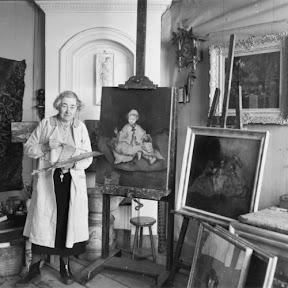
Lizzy Ansingh was a famous Dutch painter, noted for her doll paintings. What made her paintings so unique was her representation of dolls not as mere objects, but as animate things. In the history of Dutch art, her paintings belonged to a unique genre.
Her early paintings and drawings were heavily influenced from her religious upbringing, which mostly consisted of images of angels and biblical scenes. She learned painting from her aunt, Therese Schwartze, who was a noted painter in her own right and who encouraged Lizzy to take up painting as a career.
Thérèse Schwartze-Self-portrait
Self-portrait with palette


Also, her aunt encouraged Lizzy to carry on working on her doll themes. With this aim in view, she joined the Amsterdam Royal Academy for Visual Arts to hone her craft. At the academy, she joined a group of female painters, who later became famous as the Amsterdamse Joffers.
Dolls

Apart from dolls, she was also quite skilled at portrait paintings. The biography given below will tell you more about this painter.
Girl with Medaillon
Lezende vrouw met modieuze hoed-Elegant lady
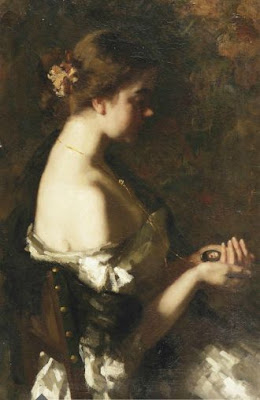

Lizzy Ansingh, also known as Maria Elisabeth Georgina Ansingh, was born in the Dutch province of Utrecht, in Netherlands, to Edzard Willem Ansingh and Clara Theresia Schwartze. Her father was a pharmacist and her mother was a painter. Clara Theresia was the niece of the famous painter Therese Schwartze, who taught Lizzy drawing, and the granddaughter of the painter, Johann Georg Schwartze.
***
Lizzy Ansingh as a Young Girl by Thérèse Schwartze
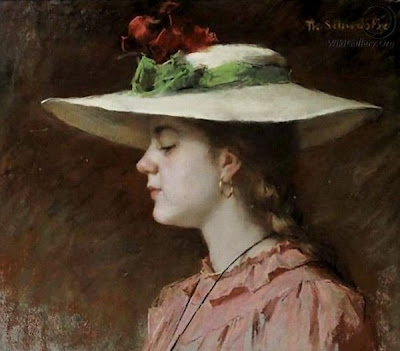
Portrait Lizzy Ansingh by Thérèse Schwartze

Portrait of Lizzy Ansingh by Thérèse Schwartze.1902
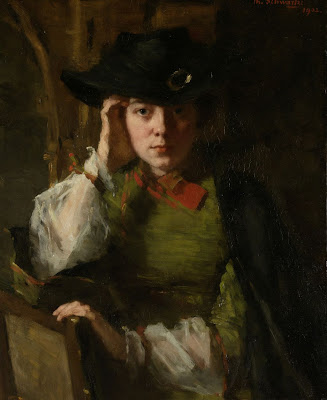
***
My sister Treesje (Sorella)

The first drawings that Lizzy made were of angels and biblical scenes. Her choice of theological themes was partly inspired by her family’s strong religious values. Her aunt had a major influence on her, with whom she stayed for 16 years, from 1892 to 1908. She encouraged Lizzy to develop her artistic career and introduced her to famous Dutch and French painters when she went with her aunt to visit museums and exhibitions, both at home and abroad. During her youth, she met many famous painters like Piet Mondriaan and George Hendrik Breitner. In 1893, she took painting lessons from the renowned painter GHC Overman and continued until 1897.
When Lizzy was 19 years old, she enrolled at the Amsterdam Royal Academy for Visual Arts where her professors included Carel Dake, Nicolaas van der Waay and August Allebe among others. There she studied Greek and Roman statues, which helped develop her knowledge of anatomy and helped her grow as a portrait painter. She left the Academy in 1897. At the Academy, she formed a strong bonding with a group of female painters like Marie van Regteren Altena, Coba Ritsema, Ans van den Berg, Jacoba Surie, Nelly Bodenheim, Jo Bauer-Stumpff and Betsy Westendorp-Osieck.
Portreit (1905) of Maria Elisabeth Georgina ('Lizzy')by Coba Ritsema
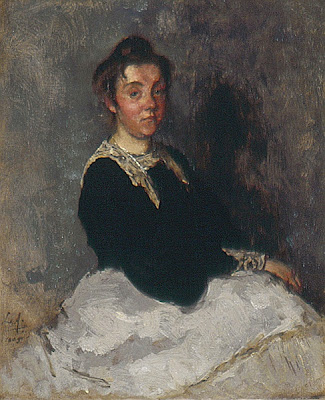
*из архива ЖЖ: Art Links:Jacoba Johanna (Coba) Ritsema (1876 - 1961)
She and her friends were highly inspired by the art critic Albert Plasschaert. Later, this school of painters came to be known as Amsterdamse Joffers. After the 1970s, the Amsterdamse Joffers became the role models for a younger generation of female painters in Netherlands.
Lizzy Ansingh:Self-portraits


Lizzy became very famous for her portraits and doll paintings. Soon after leaving the Academy, she started painting small portraits, still life, tropical birds and dolls. The earliest portrait that she painted was in 1899, which was that of her mother. This portrait received much acclaim when it was exhibited at the Amsterdam Painters Association in St. Luke in 1900. Her foray into doll painting was most inspired from the works of her aunt.
From the 1900s, her focus became painting dolls. These doll paintings depicted human virtues and vices and bore moral undertones. The most important painting of this era was a painting that depicted the seven deadly sins that she created in 1914.
De zeven hoofdzonden

***

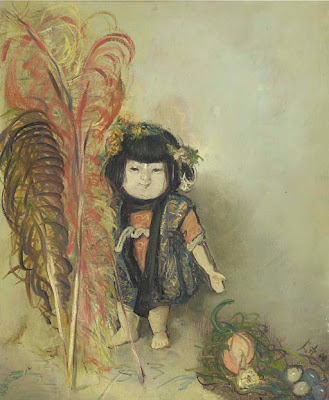

***
The new baby

The pink dress;A doll in a pink dress
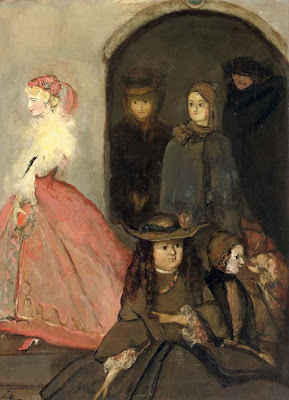

The precious chair;Two dolls


Gebakken cake;
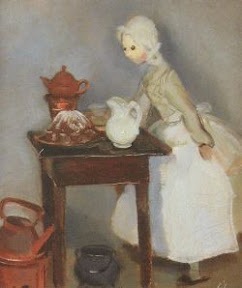

Tea-time

Even after Lizzy left her aunt’s place, they stayed in close contact with each other. In 1918, when her aunt passed away, she painted ‘The Funeral’ in her memory. The doll paintings in her later life were characterized by intimacy as well as naïve painting. Her paintings, like ‘Wedding Dolls’, which was created in 1936, show an ‘onacademische’ use of perspective while the characters have a very wooden look.
***
Rustelozen, 1926

Exhibited
Paris, Salon d' Automne Section Hollandaise, 1926
Amsterdam, Maatschappij Arti & Amicitiae, Lizzy Ansingh G. van Nifterik Coba Ritsema & Georgine Schwartze, 7-28 March 1931, no. 27
***
Het Gele Gevaar - Le Peril Jaune

Apart from painting, Lizzy also worked as an illustrator but only sporadically. In 1930, she illustrated Marie van Zeggelen’s ‘The Plaetse aan de Veght’ and ‘Twee Amsterdamsche Juffers’.
She also wrote poetry and short fiction. Some of her poetry was published in the literary magazine ‘Maatstaf’ from 1956 to 1957. In 1927, she published a book for children called ‘A little fruit basket’. She published another book in 1950 called ‘Aunt Tor has her birthday’, which was illustrated by Nelly Bodenheim. She also wrote some travel sketches like ‘Art treasures from the Prado’, published in De Telegraaf, in 1939. Lizzy was a member of two Amsterdam art circles-Arti et Amicitiae and Saint Lucas.
She died in Amsterdam on 14 December 1959. (c)-The Famous People
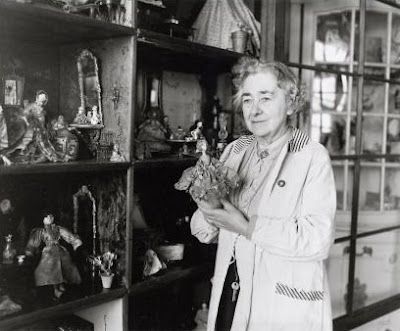

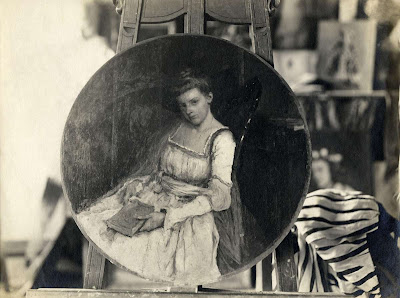
***
The source of life
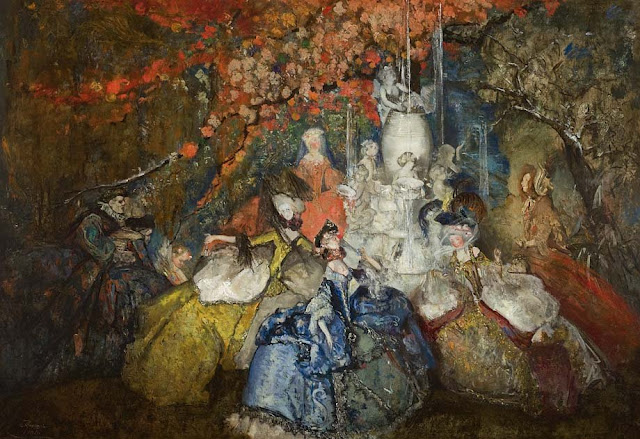
Tea party,1952
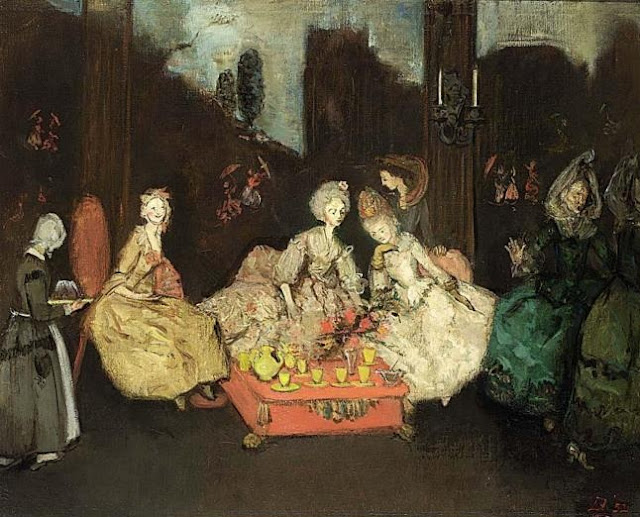


Winter:Dolls masquerade on the ice


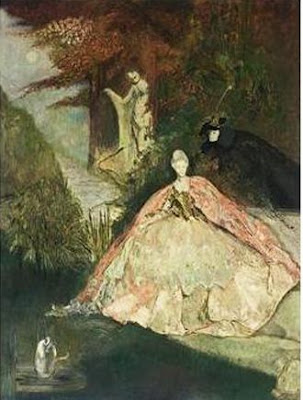
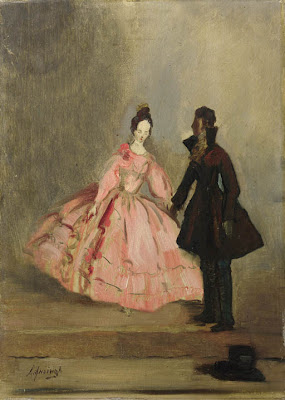
Cinderella;An elegant doll

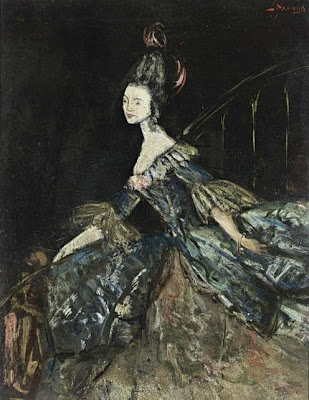

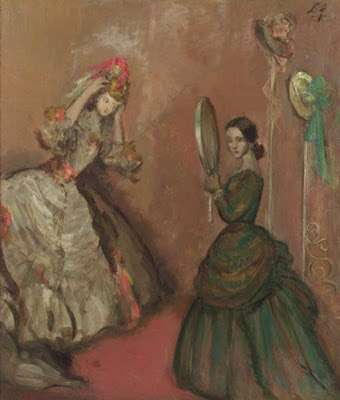
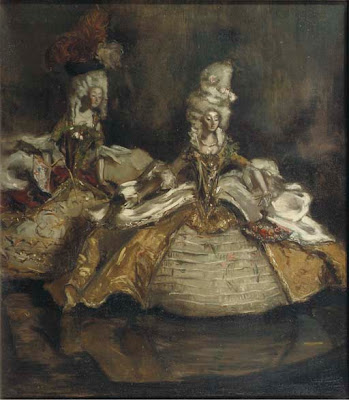
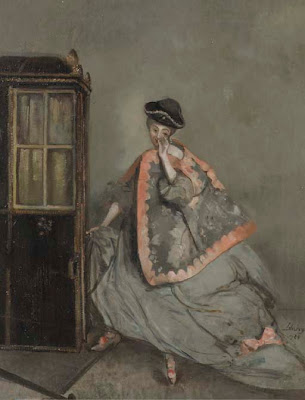
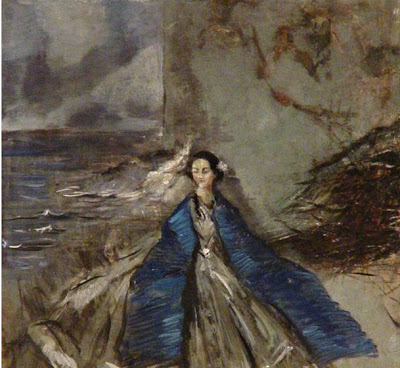


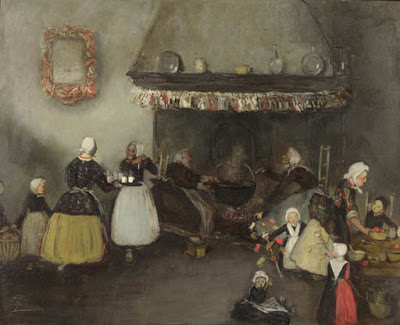
Old ladies in a carriage

***
Roepende,1955
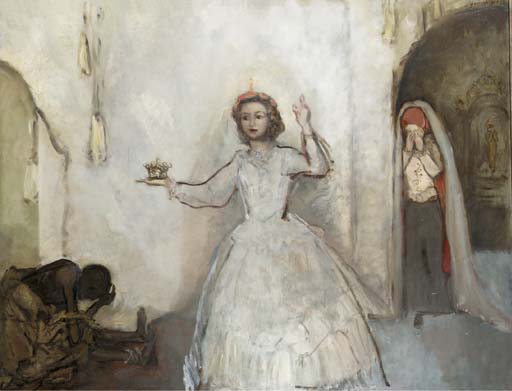
****
Indonesian lady with dog
A thought of music
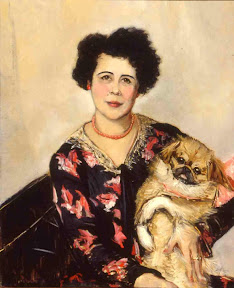

Girl in a blue dress with a bouquet of flowers
Little girl with a bird cage,1936
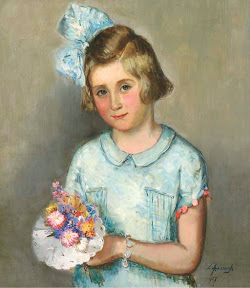


Flora

***

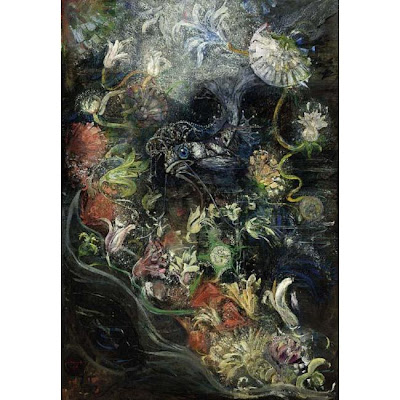
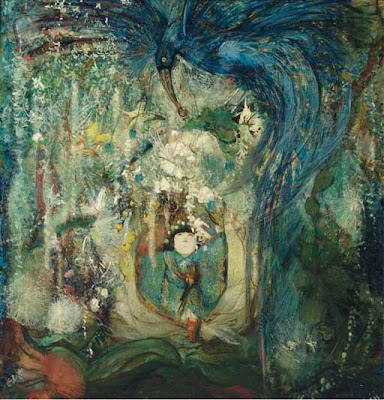

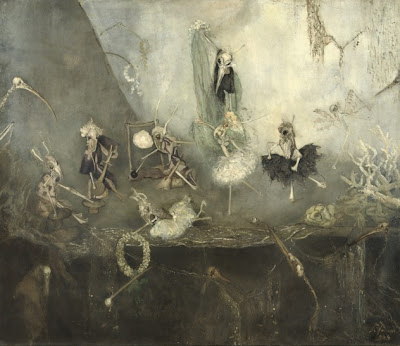
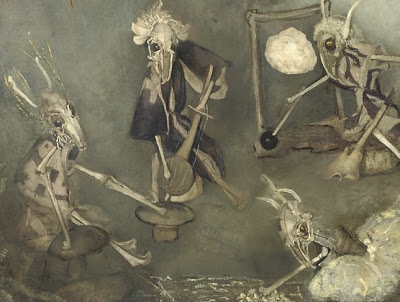
***
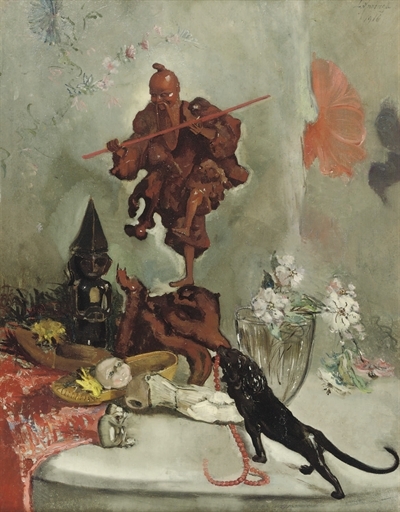


***
Joséphine in haar japon van rozenbladeren

***
Bal Masqué, 1927, watercolour on paper

*Image source:Christie's and Sotheby's
This entry was originally posted at http://elle-belle.dreamwidth.org/1734542.html. Please comment there using OpenID.
Still life with doll

Maria Elisabeth Georgina Ansingh (aka Lizzy Ansingh) was a Dutch painter. She belonged to a school of female painters called the Amsterdamse Joffers.


Lizzy Ansingh was a famous Dutch painter, noted for her doll paintings. What made her paintings so unique was her representation of dolls not as mere objects, but as animate things. In the history of Dutch art, her paintings belonged to a unique genre.
Her early paintings and drawings were heavily influenced from her religious upbringing, which mostly consisted of images of angels and biblical scenes. She learned painting from her aunt, Therese Schwartze, who was a noted painter in her own right and who encouraged Lizzy to take up painting as a career.
Thérèse Schwartze-Self-portrait
Self-portrait with palette


Also, her aunt encouraged Lizzy to carry on working on her doll themes. With this aim in view, she joined the Amsterdam Royal Academy for Visual Arts to hone her craft. At the academy, she joined a group of female painters, who later became famous as the Amsterdamse Joffers.
Dolls

Apart from dolls, she was also quite skilled at portrait paintings. The biography given below will tell you more about this painter.
Girl with Medaillon
Lezende vrouw met modieuze hoed-Elegant lady


Lizzy Ansingh, also known as Maria Elisabeth Georgina Ansingh, was born in the Dutch province of Utrecht, in Netherlands, to Edzard Willem Ansingh and Clara Theresia Schwartze. Her father was a pharmacist and her mother was a painter. Clara Theresia was the niece of the famous painter Therese Schwartze, who taught Lizzy drawing, and the granddaughter of the painter, Johann Georg Schwartze.
***
Lizzy Ansingh as a Young Girl by Thérèse Schwartze

Portrait Lizzy Ansingh by Thérèse Schwartze

Portrait of Lizzy Ansingh by Thérèse Schwartze.1902

***
My sister Treesje (Sorella)
The first drawings that Lizzy made were of angels and biblical scenes. Her choice of theological themes was partly inspired by her family’s strong religious values. Her aunt had a major influence on her, with whom she stayed for 16 years, from 1892 to 1908. She encouraged Lizzy to develop her artistic career and introduced her to famous Dutch and French painters when she went with her aunt to visit museums and exhibitions, both at home and abroad. During her youth, she met many famous painters like Piet Mondriaan and George Hendrik Breitner. In 1893, she took painting lessons from the renowned painter GHC Overman and continued until 1897.
When Lizzy was 19 years old, she enrolled at the Amsterdam Royal Academy for Visual Arts where her professors included Carel Dake, Nicolaas van der Waay and August Allebe among others. There she studied Greek and Roman statues, which helped develop her knowledge of anatomy and helped her grow as a portrait painter. She left the Academy in 1897. At the Academy, she formed a strong bonding with a group of female painters like Marie van Regteren Altena, Coba Ritsema, Ans van den Berg, Jacoba Surie, Nelly Bodenheim, Jo Bauer-Stumpff and Betsy Westendorp-Osieck.
Portreit (1905) of Maria Elisabeth Georgina ('Lizzy')by Coba Ritsema

*из архива ЖЖ: Art Links:Jacoba Johanna (Coba) Ritsema (1876 - 1961)
She and her friends were highly inspired by the art critic Albert Plasschaert. Later, this school of painters came to be known as Amsterdamse Joffers. After the 1970s, the Amsterdamse Joffers became the role models for a younger generation of female painters in Netherlands.
Lizzy Ansingh:Self-portraits

Lizzy became very famous for her portraits and doll paintings. Soon after leaving the Academy, she started painting small portraits, still life, tropical birds and dolls. The earliest portrait that she painted was in 1899, which was that of her mother. This portrait received much acclaim when it was exhibited at the Amsterdam Painters Association in St. Luke in 1900. Her foray into doll painting was most inspired from the works of her aunt.
From the 1900s, her focus became painting dolls. These doll paintings depicted human virtues and vices and bore moral undertones. The most important painting of this era was a painting that depicted the seven deadly sins that she created in 1914.
De zeven hoofdzonden

***



***
The new baby

The pink dress;A doll in a pink dress

The precious chair;Two dolls


Gebakken cake;


Tea-time

Even after Lizzy left her aunt’s place, they stayed in close contact with each other. In 1918, when her aunt passed away, she painted ‘The Funeral’ in her memory. The doll paintings in her later life were characterized by intimacy as well as naïve painting. Her paintings, like ‘Wedding Dolls’, which was created in 1936, show an ‘onacademische’ use of perspective while the characters have a very wooden look.
***
Rustelozen, 1926

Exhibited
Paris, Salon d' Automne Section Hollandaise, 1926
Amsterdam, Maatschappij Arti & Amicitiae, Lizzy Ansingh G. van Nifterik Coba Ritsema & Georgine Schwartze, 7-28 March 1931, no. 27
***
Het Gele Gevaar - Le Peril Jaune

Apart from painting, Lizzy also worked as an illustrator but only sporadically. In 1930, she illustrated Marie van Zeggelen’s ‘The Plaetse aan de Veght’ and ‘Twee Amsterdamsche Juffers’.
She also wrote poetry and short fiction. Some of her poetry was published in the literary magazine ‘Maatstaf’ from 1956 to 1957. In 1927, she published a book for children called ‘A little fruit basket’. She published another book in 1950 called ‘Aunt Tor has her birthday’, which was illustrated by Nelly Bodenheim. She also wrote some travel sketches like ‘Art treasures from the Prado’, published in De Telegraaf, in 1939. Lizzy was a member of two Amsterdam art circles-Arti et Amicitiae and Saint Lucas.
She died in Amsterdam on 14 December 1959. (c)-The Famous People



***
The source of life

Tea party,1952


Winter:Dolls masquerade on the ice




Cinderella;An elegant doll









Old ladies in a carriage

***
Roepende,1955

****
Indonesian lady with dog
A thought of music


Girl in a blue dress with a bouquet of flowers
Little girl with a bird cage,1936



Flora

***






***


***
Joséphine in haar japon van rozenbladeren
***
Bal Masqué, 1927, watercolour on paper

*Image source:Christie's and Sotheby's
This entry was originally posted at http://elle-belle.dreamwidth.org/1734542.html. Please comment there using OpenID.